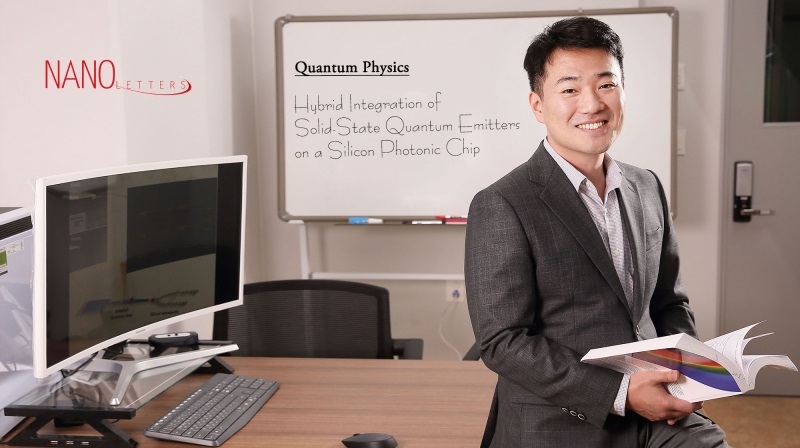Nov 28, 2017
Joo Hyeon Heo
An international team of researchers, affiliated with UNIST has presented a core technology for quantum photonic devices used in quantum information processing. They have proposed combining of quantum dots for generating light and silicon photonic technologies for manipulating light on a single device.
This breakthrough has been led by Professor Je-Hyung Kim in the School of Natural Science at UNIST in collaboration with Professor Edo Waks and a group of researchers at the University of Maryland, United States.
In this study, the research team demonstrated the integration of silicon photonic devices with a solid-state single photon emitter. We use a hybrid approach that combines silicon photonic waveguides with InAs/InP quantum dots that act as efficient sources of single photons at telecom wavelengths spanning the O-band and C-band.
![]()
Schematic of the integrated InP nanobeam and silicon waveguide.
In classical computing, a bit is a single piece of information that can exist in two states – 1 or 0. Quantum computers uses quantum bits that can occupy 0, 1, or a a superposition that can be both at the same time. Although there are several potentially fruitful approaches exist to quantum information processing based on a variety of quantum technologies, including atom, light, and superconducting devices. However, the future of quantum computing, like the quantum state itself, still remains uncertain. Professor Kim focuses on the quantum information processing, using light. This is because quantum bits can be implemented using the polarized state of light, its duration, and the route information, similar to electron spins.
A recently developed quantum light source exhibits the characteristics of quantum physics, including the superposition, quantum entanglement, and no-cloning theorem. This has enabled innovative application technologies, such as quantum simulators, quantum state transfer, and quantum cryptography. However, in order to commercialize the technologies used for the actual quantum information processing technology, it is necessary to perform quantum optics experiments directly on the photonic device. According to the research team, such innovation could be the precursor for quantum circuits, which are expected to play a large role in the future of quantum computers and communication.
“In order to build photon-based integrated quantum optical devices, it is necessary to produce as many quantum light sources as possible in a single chip,” says Professor Kim. “Through this study, we have proposed the basic form of quantum optical devices by producing highly effective quantum light source with quantum dots and creating the pathway to manipulate light with the use of silicon substrates.”
![]()
A scanning electron microscope image of the fabricated nanobeam that is suspended by thin tethers that attach it to the bulk substrate.
Quantum dots are ultrafine particles or nanocrystals of a semiconductor material with fiameters in the range of 2 to 10 nanometers (A nanometer is one billionth of a meter). In general, quantum dots take the form of compounds. However, as the size decreases, they begin to exhibit discontinuous energy structure, which results in having similar properties to the light emitted by atoms. Although quantum dots have been used successfully as highly efficient single-photon sources, they had difficulty controlling light.
In the study, the research team demonstrated the integration of silicon photonic devices with a solid-state single photon emitter. Here, they used a hybrid approach that combines silicon photonic waveguides with InAs/InP quantum dots that act as efficient sources of single photons at telecom wavelengths spanning the O-band and C-band. Then, they removed the quantum dots via a pick-and-place procedure with a microprobe tip combined with a focused ion beam and scanning electron microscope. This technique allowed transferring of tapered InP nanobeams containing InAs quantum dots onto a silicon waveguide with nanometer-scale precision.
“This integration opens up the possibility to leverage the highly advanced photonics capabilities developed in silicon to control and route nonclassical light from on-demand single photon sources,” the research team notes. “In addition, the fabricated devices operate at telecom wavelengths and can be electrically driven, which are useful for fiber-based quantum communication.”
The quantum optical device, developed by the research team has successfully transferred the emission from the quantum dots along the silicon photonic circuits with high efficiency. Using this, they also successfully incorporate an on-chip silicon-photonic beamsplitter to perform a Hanbury-Brown and Twiss measurement.
![]()
Professor Je-Hyung Kim in the School of Natural Science at UNIST.
“Our approach could enable integration of precharacterized III–V quantum photonic devices into large-scale photonic structures to enable complex devices composed of many emitters and photons,” says Professor Kim.
The findings of this study have been published online in the prestigious journal, Nano Letters on November 13, 2017.
Journal Reference
Je-Hyung Kim et al., “Hybrid Integration of Solid-State Quantum Emitters on a Silicon Photonic Chip,” (2017), Nano Letters.















